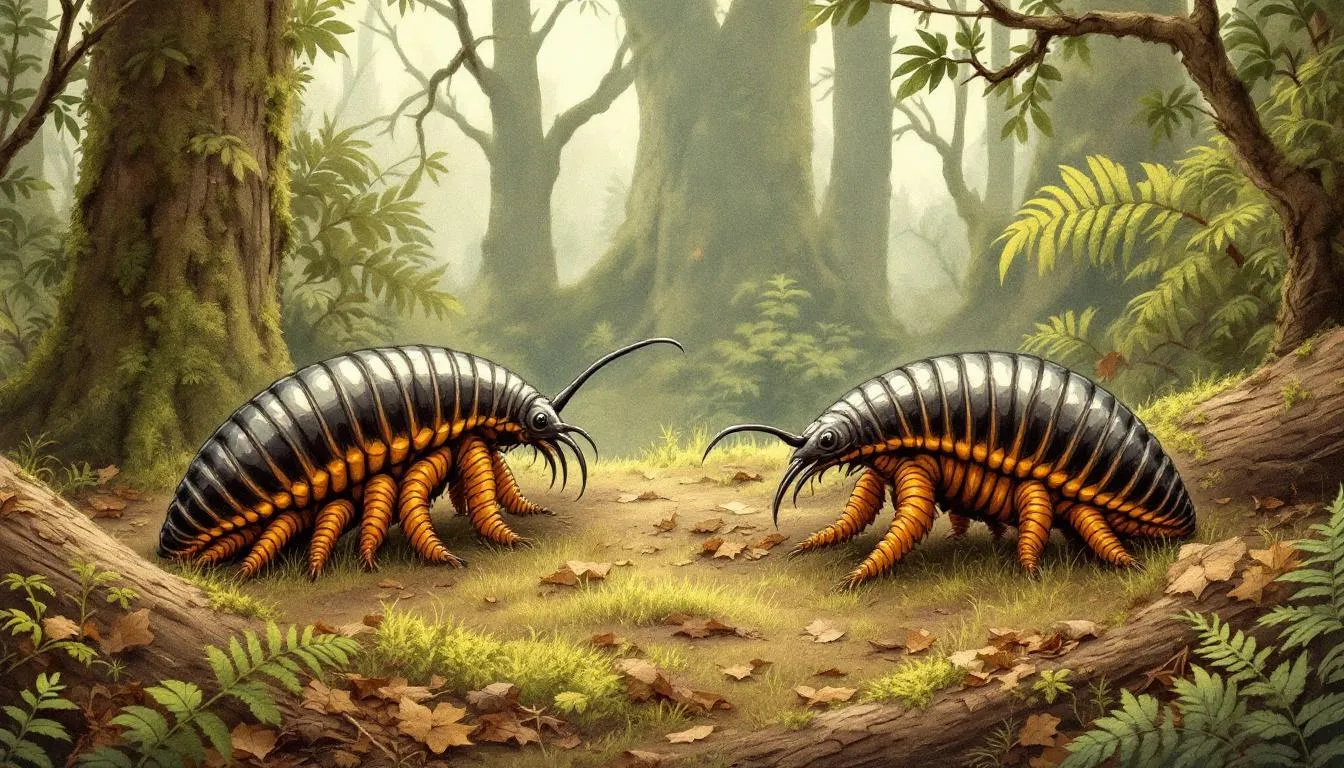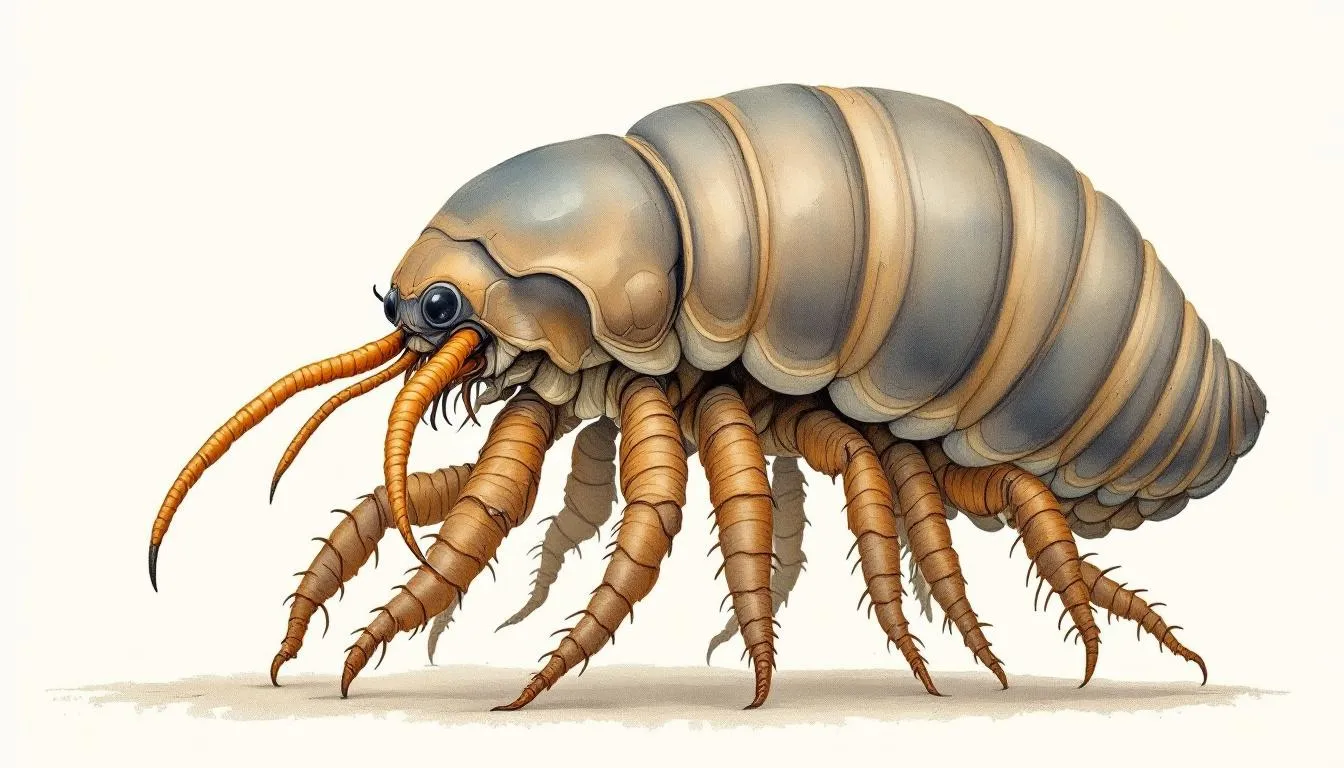A giant woodlouse is a sizable isopod typically found in rocky, coastal regions where they live under stones and in crevices. They are unique because they can breathe underwater, using gills that require a moist environment. These creatures play a vital role in breaking down organic matter, contributing to their ecosystem’s health. In this article, we’ll explore their habitat, physical characteristics, and more.
Key Takeaways
-
Giant woodlice inhabit rocky coastal areas, relying on moist environments for shelter and contributing significantly to nutrient cycling by breaking down organic matter.
-
Physically distinct with a pale lilac hue, giant woodlice possess fourteen legs, sensory antennae, and an ability to roll into a ball for protection against predators.
-
Their unique adaptations allow them to breathe underwater and thrive in specific coastal habitats, where they play a crucial role in maintaining ecosystem health by recycling nutrients and detoxifying the environment.
Habitat of Giant Woodlice

Giant woodlice are most commonly found in rocky coastal regions, where they make their homes under large stones and within crevices. These environments provide the necessary moisture for their survival and protection from predators and the elements. Unlike their terrestrial relatives, giant woodlice prefer these coastal beach locales, thriving in the damp microhabitats created by the interplay of rocks and sea spray.
Pill bugs, often found in similar moist environments, share a lot in common with giant woodlice in terms of habitat preferences and diet. Both species favor the spaces beneath large stones and in crevices, capitalizing on the humid and protected conditions these areas provide. This shared habitat preference underscores the importance of moisture and shelter in the life of a woodlouse.
In these rocky coastal regions, giant woodlice contribute significantly to the ecological balance. They help maintain their environment’s health by breaking down organic material. Their presence under boulders and cliffs not only aids in nutrient cycling but also helps break a diverse range of other organisms that thrive in these unique habitats.
Physical Characteristics

Giant orange woodlice are a sight to behold, with their distinctive physical characteristics setting them apart from other isopods, including the giant isopod and giant isopods. These creatures can grow up to 3 cm in length, making them larger than many of their terrestrial relatives. Their bodies feature a pale lilac or pinkish hue, which can sometimes appear grey under different lighting conditions. This coloration provides them with an effective camouflage against the rocky, coastal backdrop where they reside.
A closer look at a giant woodlouse reveals:
-
A total of fourteen legs, arranged in seven pairs
-
Two pairs of sensory antennae, which are crucial for navigating their environment, helping them detect food and avoid predators
-
Large eyes positioned on the sides of their head, providing a wide field of vision essential for spotting threats and locating resources in their dimly lit habitats
The body of a giant woodlouse is divided into several segments, each providing a degree of flexibility and protection. The overlapping segments form a tough exoskeleton, rich in calcium, which shields them from predators and environmental hazards. This segmented body shape, combined with their ability to roll into a ball, offers them a unique defense mechanism against potential threats.
Breathing Underwater
One of the most fascinating aspects of giant woodlice is their ability to breathe underwater. This remarkable capability is facilitated by their gills, which require a moist environment to function effectively. The pleopods, located on the underside of their bodies, act as gills that absorb oxygen from the surrounding water. This adaptation is crucial, as it allows giant woodlice to thrive in the damp, rocky habitats they call home.
However, the reliance on moisture for respiration also means that giant woodlice are highly susceptible to drying out. If their gills become too dry, they can no longer absorb oxygen efficiently, leading to suffocation. This necessity for a moist environment explains their preference for coastal regions, where the humidity levels are consistently high enough to support their respiratory needs.
The ability to breathe underwater not only enables giant woodlice to survive but also allows them to exploit a niche that many other terrestrial isopods cannot. Lives in these moist environments allows them to avoid competition with land-dwelling species and capitalize on the unique coastal resources.
Diet and Feeding Habits

Giant woodlice are primarily scavengers, playing a vital role in their ecosystem by breaking down decomposing organic matter. Their diet mainly consists of dead and decaying plant material, such as seaweed, which they find in abundance in their coastal habitats. Consuming this organic matter helps recycle nutrients, promoting the health and growth of surrounding plant life.
In addition to plant material, giant woodlice also feed on carrion, including dead animals and even members of their own species when they are vulnerable. This scavenging behavior is crucial for maintaining the cleanliness of their environment, as it prevents the accumulation of dead organic matter that could otherwise harbor harmful pathogens. They eat carrion and meat, which helps in this process.
The role of giant woodlice as scavengers cannot be overstated. They contribute to the nutrient cycle by breaking down dead plant and animal material, enriching the soil and supporting new vegetation growth. Ongoing research continues to explore their dietary habits, shedding light on the intricate balance they maintain in their ecosystems.
Adaptations for Survival

Survival in the harsh coastal environments requires a range of adaptations, and giant woodlice, also known as sea slaters, have evolved several strategies to thrive in these conditions. One of their most notable defensive mechanisms is their ability to roll into a ball when threatened. This behavior, known as conglobation, protects their vulnerable undersides and presents a tough, armored exterior to potential predators.
Their coloration also plays a key role in their survival. The pale lilac or pinkish hues of giant woodlice allow them to blend seamlessly into their rocky surroundings, making it difficult for predators to spot them. This natural camouflage, combined with their tough exoskeleton, offers significant protection against predation.
Giant woodlice have several remarkable features:
-
Equipped with sensory long antennae that help them detect changes in their environment, enhancing their survival instincts.
-
Use these antennae particularly for finding food and avoiding danger.
-
Known to survive without food for extended periods, sometimes over five years, highlighting their remarkable adaptability to scarce food conditions.
Importance in Ecosystems
Giant woodlice play a crucial role in maintaining the health and balance of their ecosystems. Breaking down organic matter, such as seaweed and dead animals, contributes significantly to nutrient cycling. This process enriches the soil, promoting the growth of plants and supporting a diverse range of organisms in their habitats.
In addition to nutrient cycling, giant woodlice help purify the soil and groundwater by absorbing and removing heavy metals like mercury and cadmium. This detoxifying ability is vital for maintaining clean and healthy environments, particularly in coastal regions where pollutants can accumulate.
Their feeding habits also prevent the buildup of organic waste in their habitats, reducing the risk of disease and promoting overall ecosystem health. In bio active set ups, such as terrariums, giant woodlice thrive alongside plants and other microfauna, contributing to the sustainability of these miniature ecosystems through eating.
Comparison with Other Isopods
Giant woodlice share many characteristics with other isopods, particularly in terms of lifestyle and habitat preferences. For instance, isopod commonly pill bugs, found in gardens and other moist environments, exhibit similar behaviors, such as rolling into a ball for defense. This convergent evolution highlights the common environmental pressures faced by these creatures.
Despite these similarities, giant woodlice stand out due to their larger size and specific coastal habitat. Unlike their terrestrial relatives, they are adapted to life in the rocky coastal regions, where they exploit unique resources and avoid competition with land-dwelling isopods. This specialization underscores the diversity within the isopod family and the various ecological niches they occupy.
Comparing giant woodlice to other crustaceans, such as crabs, reveals interesting parallels and differences. While both groups belong to the larger class Crustacea, their adaptations to different environments and lifestyles highlight the incredible diversity and evolutionary history of this group of animals.
Captivity and Care

Keeping giant woodlice in captivity requires careful attention to their environmental needs. They thrive in enclosures with:
-
High humidity levels, at least 55%
-
Temperatures ranging between 70-85°F
-
Adequate ventilation to prevent excess moisture buildup and ensure a healthy environment.
A calcium-rich diet with high calcium content is crucial for maintaining the health of giant woodlice in captivity. Foods like Repashy Bug Burger can provide the necessary nutrients to support their growth and development. Additionally, providing a habitat with plenty of hiding spots, such as crevices and shelters, mimics their natural environment and helps reduce stress.
In captivity, giant woodlice can serve as excellent terrarium custodians, helping to break down organic matter and maintain a clean environment. Their role as a clean-up crew in a bio-active setup makes them valuable additions to any terrarium or vivarium, contributing to the overall health and balance of these ecosystems.
Research and Discoveries
The world of giant woodlice continues to be a subject of scientific interest, with new species being discovered and studied regularly for long periods. Recent findings have expanded our understanding of their genetic diversity and evolutionary history, shedding light on the deeper complex relationships within the genus Bathynomus and among larger species, including how they may breed.
Ongoing research aims to uncover more about their biology, ecology, and potential applications in environmental science related to these findings, allowing us to discover more insights that are exposed.
Summary
In conclusion, giant woodlice are fascinating creatures that play a vital role in their ecosystems. From their unique physical characteristics and survival adaptations to their crucial role in nutrient cycling and soil purification, these coastal custodians are essential for maintaining environmental balance. As we continue to study and appreciate these remarkable isopods, we gain a deeper understanding of the intricate web of life that sustains our planet. Let us celebrate and protect these hidden marvels of the coastal world!
Frequently Asked Questions
Where are giant woodlice typically found?
Giant woodlice are typically found in rocky coastal regions, under large stones and in crevices, as they thrive in moist environments.
How do giant woodlice breathe underwater?
Giant woodlice breathe underwater through gills situated beneath their bodies, necessitating a moist environment for effective oxygen absorption.
What do giant woodlice eat?
Giant woodlice primarily eat decomposing organic matter, including seaweed and carrion, serving an essential role as scavengers in their ecosystem.
How do giant woodlice defend themselves?
Giant woodlice defend themselves by rolling into a ball, which exposes their tough, armored exterior and shields their vulnerable undersides from potential predators.
What role do giant woodlice play in their ecosystem?
Giant woodlice play a crucial role in their ecosystem by breaking down organic matter, which aids nutrient cycling, purifies soil and groundwater by absorbing heavy metals, and prevents the accumulation of organic waste.









